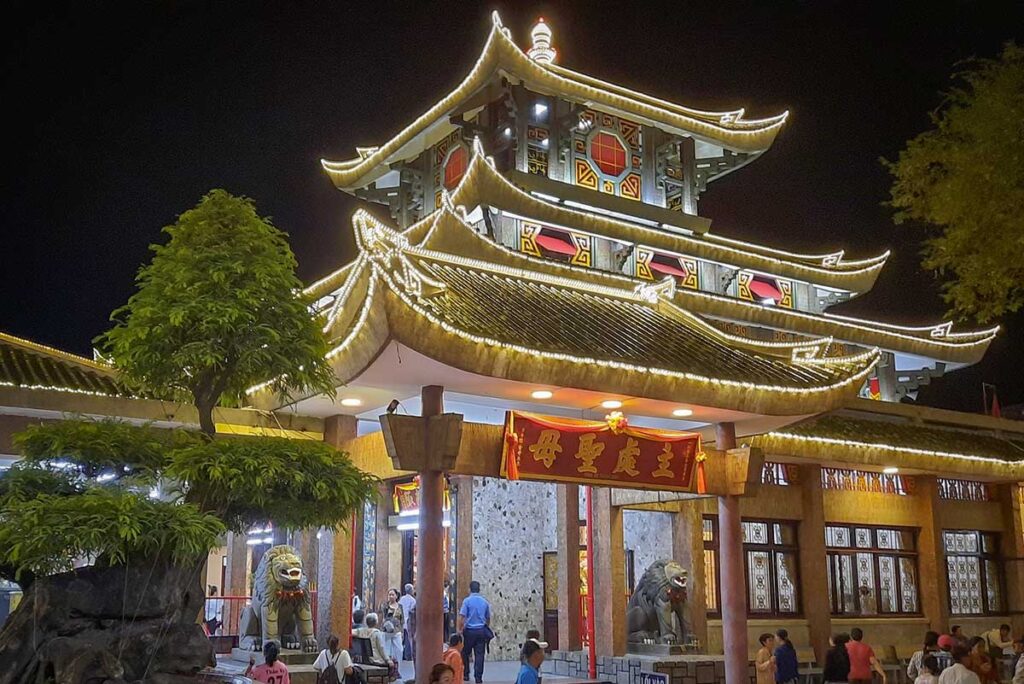What is the Ba Chua Xu Festival?
The Ba Chua Xu Festival centers on the worship of Bà Chúa Xứ, often translated as the “Lady of the Realm” or “Mother Goddess.” She is regarded as a protective deity who safeguards the land, brings prosperity, and ensures community well-being. Her cult has deep roots in the Mekong Delta, where devotion unites diverse groups, including the Kinh, Khmer, Cham, and Hoa, making the festival not only a spiritual event but also a rare expression of cultural harmony in southern Vietnam.
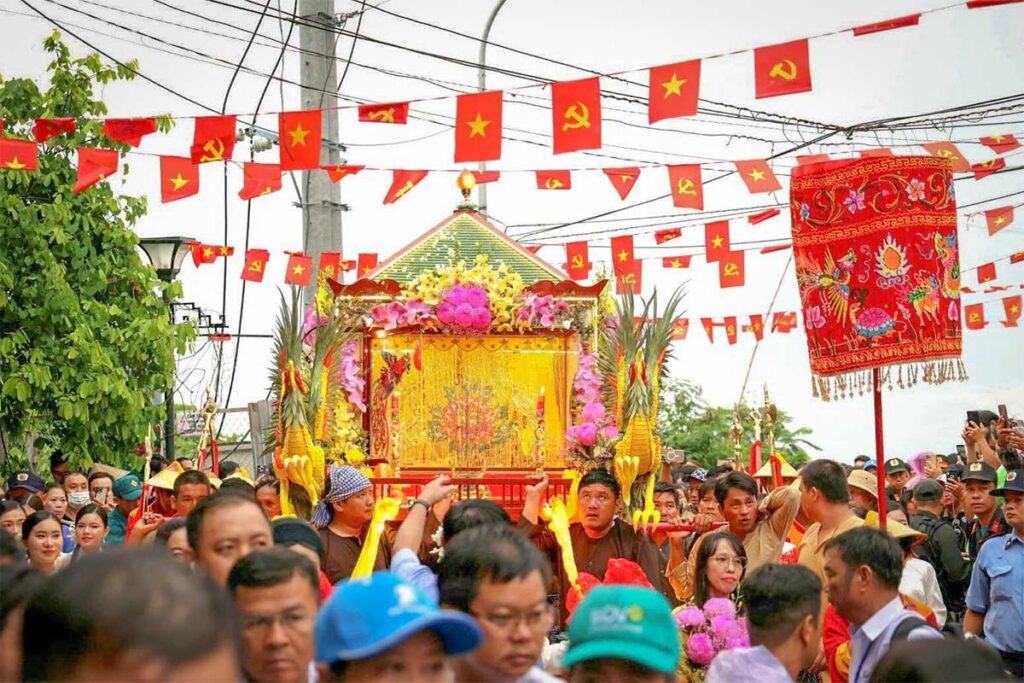
In recognition of its importance, the festival was designated a National Intangible Cultural Heritage in 2014 and, in 2024, was inscribed on UNESCO’s Representative List of the Intangible Cultural Heritage of Humanity. This recognition highlights the way the rituals are sustained by community participation, interethnic collaboration, and hands-on transmission through practice, ensuring the tradition remains a living and evolving part of Vietnam’s cultural fabric.
When is the festival held?
The Ba Chua Xu Festival takes place every year from the 22nd to the 27th day of the 4th lunar month, which usually falls in May or early June on the solar calendar. The most important ceremonies happen during the nights of the 23rd to 26th, leading up to the concluding rite on the 27th, when the festival formally closes.
Where is the festival held?
The Ba Chua Xu Festival is held at the Ba Chua Xu Temple (Miếu Bà Chúa Xứ), located at the foot of Sam Mountain (Núi Sam) in Chau Doc City, An Giang Province, in the upper Mekong Delta. While the temple serves as the main focus of worship, key rituals and processions extend across the mountain itself and include the nearby Thoại Ngọc Hầu Mausoleum, tying together the area’s sacred sites in a connected spiritual landscape.
About Ba Chua Xu Temple
History and background
Ba Chua Xu Temple was built in the early 19th century at the foot of Sam Mountain to honor the Lady of the Realm, whose stone statue was discovered nearby. Over time it became the most important pilgrimage site in An Giang, attracting worshippers year-round and culminating in the annual Ba Chua Xu Festival.
Architecture and layout
The temple follows a traditional design with layered, curved roofs and decorative details influenced by both Vietnamese and Chinese styles. Inside, the centerpiece is the large stone statue of Ba Chua Xu, richly adorned with robes and jewelry, while surrounding halls are used for offerings and preparation of ritual items.
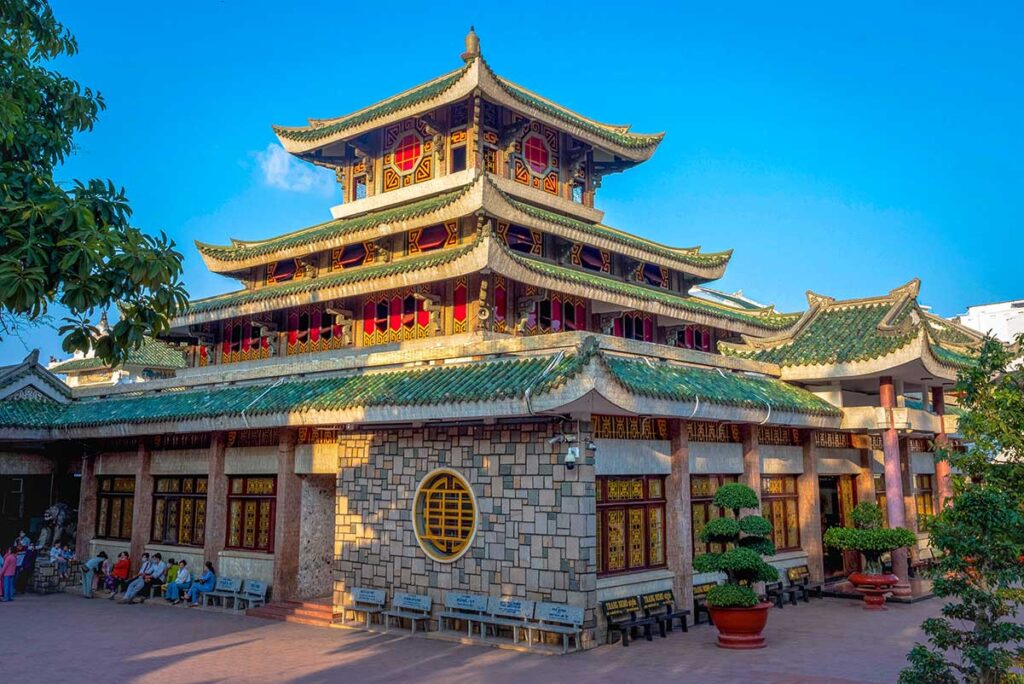
The temple today
Outside of the festival period, the temple remains active with daily worshippers and smaller ceremonies. For travelers, it offers a quieter look at local spiritual life, where incense smoke, offerings of fruit and flowers, and the steady rhythm of prayers highlight the temple’s ongoing importance in the community.
What can you see during the festival?
1. Opening procession & “inviting the Holy Mother”
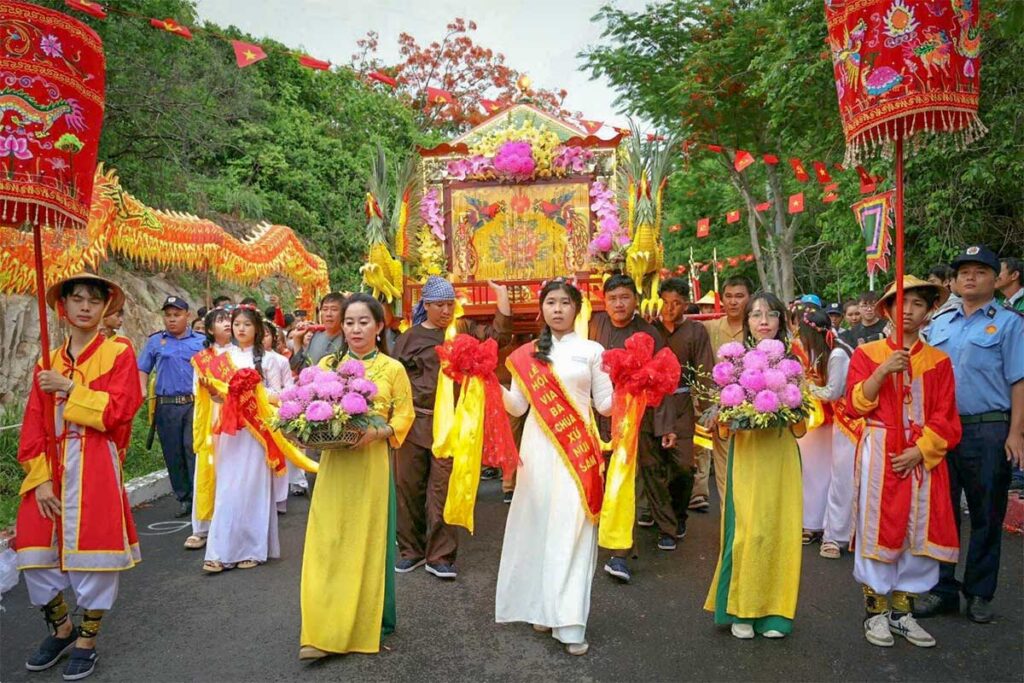
The festival opens with a night procession that includes a ceremonial climb, incense at memorial points, and the re-enactment of carrying the statue between the mountain top and the temple. Drums, lion dances, and dragon troupes create a lively atmosphere along the route.
2. Bathing ceremony
The statue of the Lady is ritually bathed and dressed in new robes and jewelry. This sacred rite is usually performed with limited access, and it often takes place in the early hours after the opening procession.
3. Offering rite (night of lunar 25th)
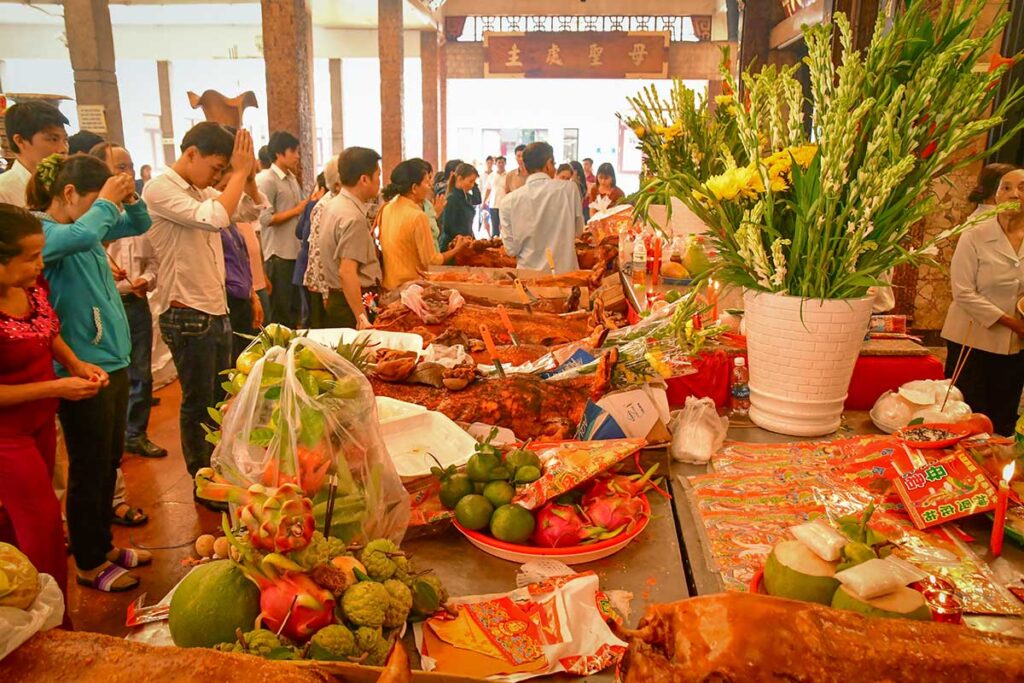

This midnight ceremony features formal offerings of food, fruits, and symbolic items. Incense is burned and prayers are made by ceremonial leaders on behalf of the community.
4. Drum rite and opera performance
A ritual drumming session at the altar signals the start of traditional opera performances. These shows combine music and theater, adding a cultural dimension to the festival nights.
5. Main sacrificial rite (dawn of lunar 26th)
The principal thanksgiving ceremony takes place at dawn. It is dedicated to asking for prosperity, good health, and favorable weather for the year ahead.
6. Returning of the tablets
Another important ritual involves moving sacred tablets and seals between the Lady’s temple and the nearby Thoai Ngoc Hau Mausoleum, symbolizing the festival’s cycle of devotion.
7. Street festival & side events
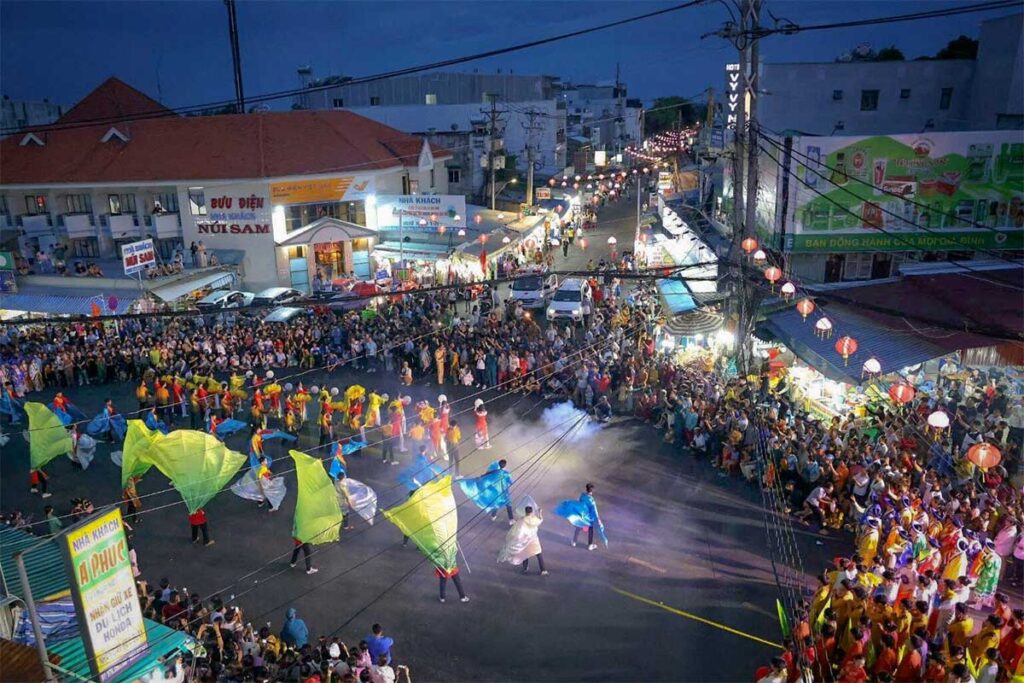
Beyond the rituals, the festival expands into a community celebration with lion and dragon dance competitions, cultural shows, food stalls, and calligraphy displays. Local specialties and regional products are also sold in makeshift markets.
8. Atmosphere & crowd dynamics

Expect large crowds, with pilgrims gathering well past midnight—sometimes until 2 or 3 am. The temple courtyards fill with long incense lines and offerings, creating an intense yet deeply spiritual atmosphere where most participants are devoted worshippers rather than casual tourists.
Practical information and tips for visiting
Base & orientation
The best base is Chau Doc, either in Sam Mountain ward (close to the temple) or in the downtown area with more hotel options. The main festival sites are clustered around the Lady Temple at the mountain’s foot, with related rituals extending to monuments and mausoleums nearby.
How to get to Chau Doc
Chau Doc is accessible by road from Ho Chi Minh City (roughly 6–7 hours by car or bus) or from Can Tho (around 3 hours). It also connects to Ha Tien and Phu Quoc for onward travel. Speedboats run from Chau Doc to Phnom Penh, though this is not part of the festival logistics.
When to arrive & how long to stay
If you want to see the key rituals, plan to be there between the 23rd and 26th lunar days, especially pre-dawn on the 26th for the main ceremony. Staying 1–2 nights gives you enough time to experience both the procession and the bathing rite without feeling rushed.
Where to watch the main rites
The procession path between Sam Mountain and the temple is one of the most atmospheric spots, but it gets very crowded. The temple forecourt offers proximity to the main altar but requires patience in long lines. The opera and drumming area is easier to watch if you arrive early to claim a spot.
Etiquette & offerings
Dress modestly, covering shoulders and knees, and remove hats when entering sacred areas. Bring small offerings such as fruit, flowers, or incense, but follow the guidance of temple staff. Do not touch the statue or altar fittings, and place money only in official donation boxes.
Safety & comfort
Expect dense crowds, especially at night. The festival falls in May–June, so heat and sudden rains are common. Keep valuables secure, carry water, and bring a small towel or fan. Earplugs can help near drums, and it’s wise to step back from pushing crowds during peak moments.
Photography & filming
Photography is allowed in most public areas, but avoid flash during ceremonies. Always respect worshippers by keeping some distance. Step aside for lion and dragon troupes or the statue procession. Drones are generally not appropriate without official permission.
Accessibility
Sam Mountain has uneven terrain and stairs, and heavy crowds make navigation challenging for anyone with mobility issues. Arriving earlier in the day improves your chances of finding a safe, comfortable viewing position.
Pair it with other sights
The Thoai Ngoc Hau Mausoleum is directly tied to the festival rituals and worth visiting. Around Sam Mountain you’ll find other small temples and panoramic viewpoints. Beyond the festival nights, consider trips to Tra Su Forest, the Ta Pa rice fields, or local food and craft streets in Chau Doc.
